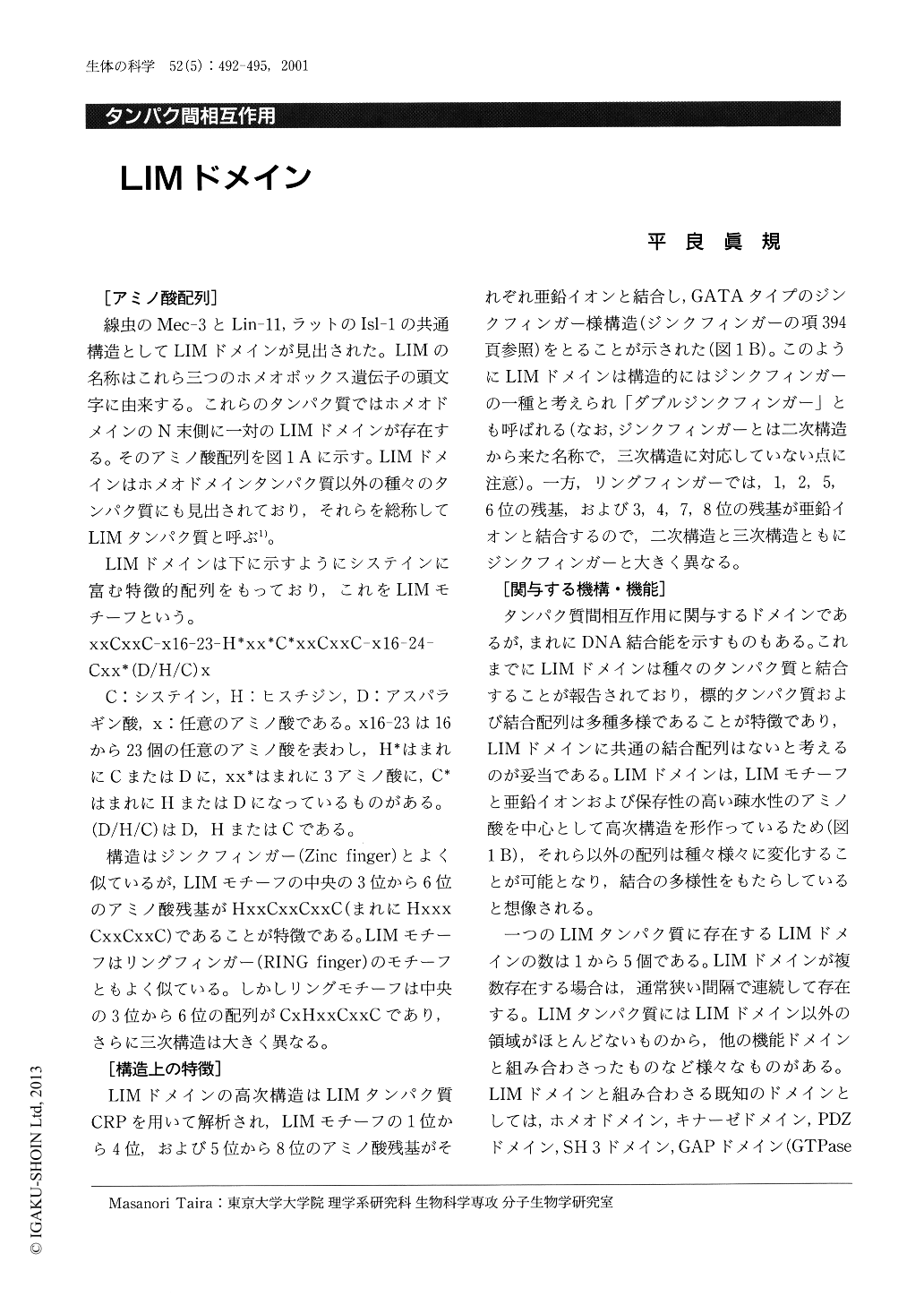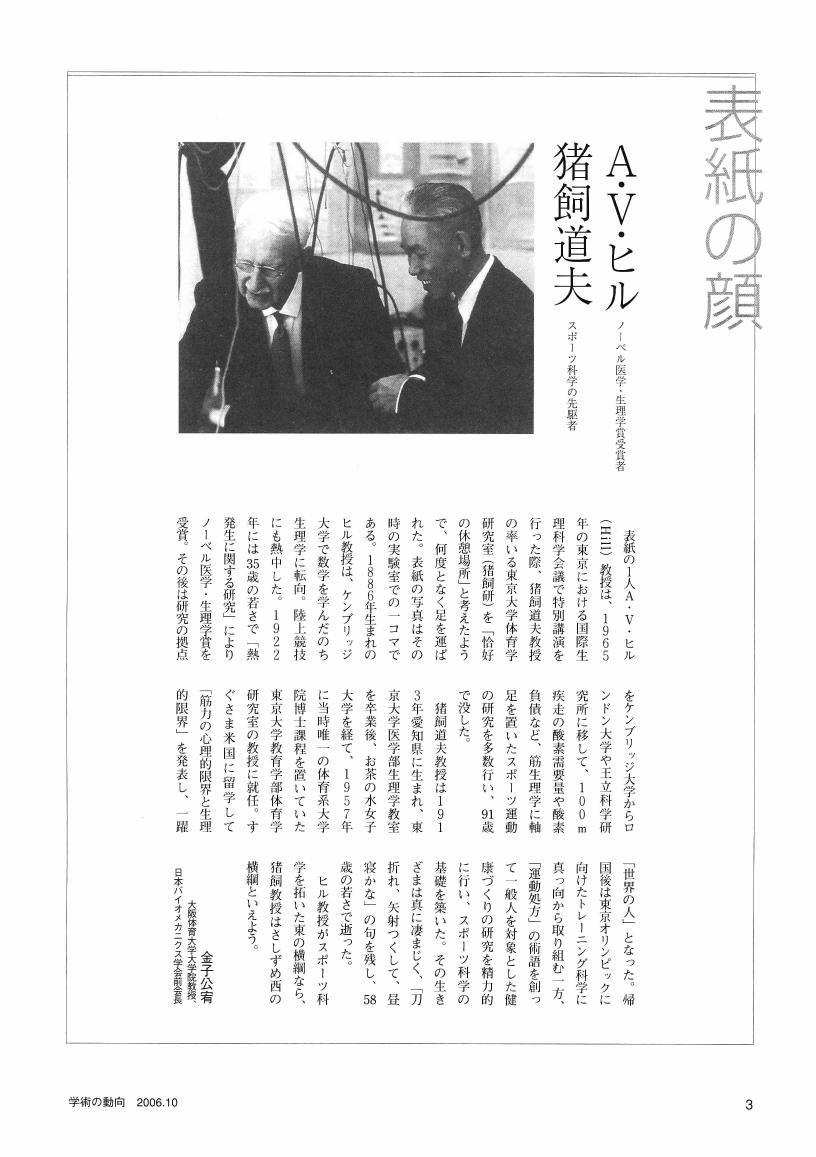2 0 0 0 近代日本の中国観 : 石橋湛山・内藤湖南から谷川道雄まで
2 0 0 0 LIMドメイン
- 著者
- 平良 眞規
- 出版者
- 金原一郎記念医学医療振興財団
- 巻号頁・発行日
- pp.492-495, 2001-10-15
[アミノ酸配列] 線虫のMec-3とLin-11,ラットのIsl-1の共通構造としてLIMドメインが見出された。LIMの名称はこれら三つのホメオボックス遺伝子の頭文字に由来する。これらのタンパク質ではホメオドメインのN末側に一対のLIMドメインが存在する。そのアミノ酸配列を図1Aに示す。LIMドメインはホメオドメインタンパク質以外の種々のタンパク質にも見出されており,それらを総称してLIMタンパク質と呼ぶ1)。 LIMドメインは下に示すようにシステインに富む特徴的配列をもっており,これをLIMモチーフという。
2 0 0 0 OA 林内殖民制度に関する研究:北大演習林の林内殖民制度
- 著者
- 有永 明人
- 出版者
- 北海道大学農学部演習林
- 雑誌
- 北海道大學農學部 演習林研究報告 (ISSN:03676129)
- 巻号頁・発行日
- vol.31, no.2, pp.141-292, 1974-08
2 0 0 0 OA A・V・ヒルノーベル医学・生理学賞受賞者猪飼道夫スポーツ科学の先駆者
- 著者
- 金子 公宥
- 出版者
- 公益財団法人 日本学術協力財団
- 雑誌
- 学術の動向 (ISSN:13423363)
- 巻号頁・発行日
- vol.11, no.10, pp.3, 2006-10-01 (Released:2009-12-21)
2 0 0 0 OA エレベーターにおける電動力応用
- 著者
- 久保田 猛彦
- 出版者
- 一般社団法人 電気設備学会
- 雑誌
- 電気設備学会誌 (ISSN:09100350)
- 巻号頁・発行日
- vol.34, no.12, pp.861-864, 2014-12-10 (Released:2015-01-07)
- 参考文献数
- 5
2 0 0 0 OA 林忠四郎先生の思い出 : 研究室はじまりの頃
- 著者
- 杉本 大一郎
- 出版者
- 日本惑星科学会
- 雑誌
- 遊・星・人 : 日本惑星科学会誌 (ISSN:0918273X)
- 巻号頁・発行日
- vol.20, no.3, pp.211-221, 2011-09-25
- 参考文献数
- 11
中澤清さんが「林太陽系の日々」と題して,「林忠四郎先生の人となり」について,3回にわたって連載された.そこでの話は,中澤さん(林研究室大学院8期生)が京都大学に在籍された時期(1965〜1982年度)に,また研究については太陽系起源に限ったものであるとされている.それを補うものとして,林研究室開設の頃のことと,林先生の京都大学定年退官(1985年3月)以降のことについて書いて欲しいと,小久保編集委員に頼まれた.そう言われても,私が林研究室に在籍したのは大学院生の5年間(1959〜1964年度)だけだし,私は物事が済んだらさっさと片付けてしまう性格なので,記録は殆ど残っていない.それでも,林先生の研究のもう一つの大きい柱である星の進化をとおしての関係だったし,中澤さんが関係されなかった側面のことがいくつかあるので,それを紹介したい.ただし話は,私が直接に関わったことを断片的に述べるだけのことになるのを,お許しいただきたい.
2 0 0 0 OA 待ち時間と満足度を組み合わせた外来患者調査
- 著者
- 徳永 誠 渡邊 進 中根 惟武
- 出版者
- 特定非営利活動法人 日本医療マネジメント学会
- 雑誌
- 日本医療マネジメント学会雑誌 (ISSN:18812503)
- 巻号頁・発行日
- vol.7, no.2, pp.324-328, 2006-09-01 (Released:2011-03-14)
- 参考文献数
- 4
- 被引用文献数
- 1
外来患者170例において待ち時間と満足度を組み合わせた外来患者調査を行った。許容できる待ち時間の平均は、受付18分、診察待ち37分、検査23分、計算会計10分、病院滞在時間68分であり、診察待ち、検査、病院滞在時間では、許容時間よりも実際かかった時間の方が長かった。実際かかった時間が許容範囲内であった患者の割合は、診察待ち時間で45%、病院滞在時間で38%であった。満足度でも「診察待ち時間」が最も満足度が低く5段階評価の平均は3.0点であった。外来受診への満足度は、医師の診察への満足度や診察待ち時間への満足度と強い相関があった。外来待ち時間調査の際、患者の考える許容待ち時間と満足度を同時に調査すれば、待ち時間の数字だけでは捉えきれない患者の評価がわかる利点がある。
- 著者
- 横谷 明徳
- 出版者
- The Japanese Radiation Research Society
- 雑誌
- 日本放射線影響学会大会講演要旨集
- 巻号頁・発行日
- pp.74, 2009 (Released:2010-02-12)
これまで放射線のトラック構造と生物影響に深く関係する難修復性のDNA損傷の関連について、モンテカルロシミュレーションを用いた数多くの研究が行われてきた。これらの研究は、トラックがDNA分子を通過することによる直接的なエネルギー付与(直接作用)によりDNA二本鎖切断(DSB)が高い確率で生じ、LETの増大とともにその頻度も増加することを予測している。我々はこれまで、直接作用により誘発されるDSBの収率をプラスミドDNAをモデル分子として観察してきた。試料に用いたpUC18プラスミドDNAは、通常の細胞中のDNAと同じコンフォメーション(B-form)となるよう高水和状態に維持した。この条件では、1ヌクレオチドあたりの水分子は約35分子であり試料の質量中の50%を水が占めることになるが、もしOHラジカルが生成したとしても自由に拡散できるバルク水が無いゲル状の試料である。照射に用いた放射線は、日本原子力研究開発機構高崎研究所TIARA及び放射線医学総合研究所HIMACから得られるHe, C 及びNeイオンを用いた。同一LETでもイオン種によるトラック構造の違いがあるため、異イオン種間のLETの比較は注意を要する。そこで我々は、それぞれのイオン種でLETを変えながらプラスミドのコンフォメーション変化として電気泳動法によりDSBを定量した。その結果、HeイオンによるDSB生成収率は20 keV/µmに極小値をもつが、これより高LET側では急激に収率が増大し、120 keV/µmではその約4倍の値となった。しかしさらに高LET側では、再び減少に転じた。Cイオンでも80-500 keV/µmとLETを上げていくとDSB収率は増大したが、その傾向はHeイオンに比べると小さかった。Neイオンでは、300-900 keV/µmの領域ではDSB収率にほとんど変化はなかった。以上のことは、イオントラックからの直接的エネルギー付与により生じるDSBの収率はLETの増加に伴って増大するが、その傾向はイオン種によって違いがあることがわかった。本口演では、私たちと同様なLET依存性を見せる過去の知見を交えながらDSBの生成収率と生物効果に対する考察を行っていく。
2 0 0 0 OA 面白いぞ量子技術:編集にあたって/概要
2019年10月米Googleが科学誌Natureに量子コンピュータが,スーパーコンピュータでは処理に1万年を要する演算をたった200秒で行い,史上はじめて量子超越性を実証した,と発表した.量子コンピュータの新たな時代の幕開けである.量子コンピュータが脚光をあびる背景には,現在これ以上の半導体微細化が困難で,ムーアの法則が限界を迎える一方で,より高性能なコンピュータのニーズがAI,創薬,暗号化等の分野において高まっているためと考えられる.実際に量子コンピュータは金融,製造,交通,化学,情報の分野で実用化にむけた試行が進んでいる.そこで本特集では量子技術の現状を紹介いただく.
2 0 0 0 OA 梅原猛先生の講演
- 著者
- 梅原 猛 Takeshi UMEHARA
- 出版者
- 総合研究大学院大学
- 雑誌
- 進歩主義の後継ぎはなにか;高等研報告書0325
- 巻号頁・発行日
- 2002-05-17
基調講演「進歩主義の後継ぎはなにか」
2 0 0 0 OA 認知症患者との「相互了解世界」の「構築」
- 著者
- 翁 和美
- 出版者
- 社会学研究会
- 雑誌
- ソシオロジ (ISSN:05841380)
- 巻号頁・発行日
- vol.54, no.3, pp.37-54,176, 2010-02-28 (Released:2015-05-20)
- 参考文献数
- 9
The point of departure of this thesis lies in the “fact” that the management principles of S. nursing home, the first in Japan to specialize in patients suffering from dementia, aim to maintain the norms and values of daily life, which, together with the caregivers’ pattern-making practices, have led its residents to form ways of being, doing, and living similar to people without dementia. This thesis attempts to pursue and envisage a concrete pathway in the system of “mutual” recognition in S. nursing home between caregivers and residents in the broader socio-political context in Japan. Notwithstanding the transformations of the new method in the regimes of care-giving and being cared for in modern industrial societies regarding people with dementia, notably in its shift from medicalization (the “disease model”) to person-centered care (the “relational model”), we find in S. nursing home in addition that there are cognitive adjustments relative to both models and also relative to the “common” elements in the conduct of daily life that help caregivers to change their interpretations of people with dementia and to recognise them as being similar to themselves, tied to “common sense” and narrative unity in age, yet also as being “communicable” partners. In the conduct of daily life: getting up in the morning, cooking, eating, and sleeping at night - caregivers (people without dementia) are no different from people with dementia. While the “disease model” underlies caregivers’ acceptance of patients, cognitive adjustments relative to these “common” elements endorse caregivers’ sympathy for residents (patients), which, although one-sided, complete the “relational model” as the caregivers’ primary mode of operation at S. nursing home. Three key concerns may greatly enrich not only academic studies of people with dementia, but also the various regimes of care-giving and being cared for in modern industrial societies. They constitute the conditions necessary to realise a “mutual” cognition between nursing home caregivers and residents with dementia. First, the malleable qualities of a public location (the nursing home): conditions similar to a home-like atmosphere enable nursing home caregivers to forge ties through situational cognition. Second, caregivers’ pattern-making practices under the conditions of the first mode make it possible to refer to a “common” element in both people with dementia and those without: the most basic determination of people struggling to cope with their own life events, such as dementia, and improving their circumstances through their own intention and will. Lastly, the requirement that the “relational model” affiliate with the “disease model” allows nursing home caregivers to take advantage of chances of communication with people with dementia, resulting in depathologisation. Although both are one-sided, the cognitive adjustments relative to both the “disease model,” as caregivers’ full acceptance of people with dementia, and the “relational model,” as caregivers’ primary mode of operation, are necessary for “mutual” recognition between caregivers and people with dementia to take place.




